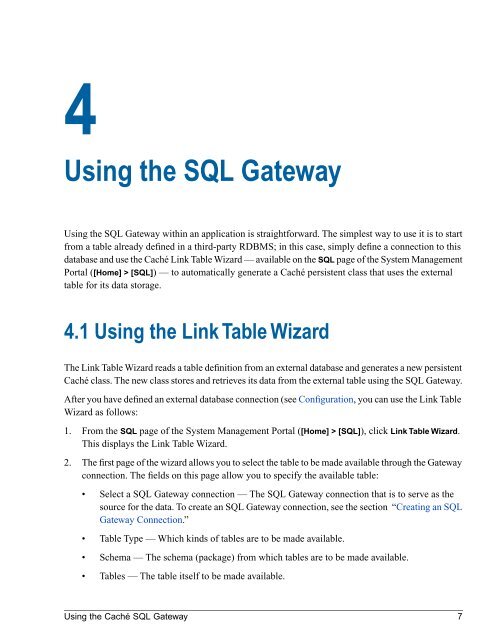Using the Caché SQL Gateway - InterSystems Documentation
Using the Caché SQL Gateway - InterSystems Documentation
Using the Caché SQL Gateway - InterSystems Documentation
You also want an ePaper? Increase the reach of your titles
YUMPU automatically turns print PDFs into web optimized ePapers that Google loves.
4<strong>Using</strong> <strong>the</strong> <strong>SQL</strong> <strong>Gateway</strong><strong>Using</strong> <strong>the</strong> <strong>SQL</strong> <strong>Gateway</strong> within an application is straightforward. The simplest way to use it is to startfrom a table already defined in a third-party RDBMS; in this case, simply define a connection to thisdatabase and use <strong>the</strong> <strong>Caché</strong> Link Table Wizard — available on <strong>the</strong> <strong>SQL</strong> page of <strong>the</strong> System ManagementPortal ([Home] > [<strong>SQL</strong>]) — to automatically generate a <strong>Caché</strong> persistent class that uses <strong>the</strong> externaltable for its data storage.4.1 <strong>Using</strong> <strong>the</strong> Link Table WizardThe Link Table Wizard reads a table definition from an external database and generates a new persistent<strong>Caché</strong> class. The new class stores and retrieves its data from <strong>the</strong> external table using <strong>the</strong> <strong>SQL</strong> <strong>Gateway</strong>.After you have defined an external database connection (see Configuration, you can use <strong>the</strong> Link TableWizard as follows:1. From <strong>the</strong> <strong>SQL</strong> page of <strong>the</strong> System Management Portal ([Home] > [<strong>SQL</strong>]), click Link Table Wizard.This displays <strong>the</strong> Link Table Wizard.2. The first page of <strong>the</strong> wizard allows you to select <strong>the</strong> table to be made available through <strong>the</strong> <strong>Gateway</strong>connection. The fields on this page allow you to specify <strong>the</strong> available table:• Select a <strong>SQL</strong> <strong>Gateway</strong> connection — The <strong>SQL</strong> <strong>Gateway</strong> connection that is to serve as <strong>the</strong>source for <strong>the</strong> data. To create an <strong>SQL</strong> <strong>Gateway</strong> connection, see <strong>the</strong> section “Creating an <strong>SQL</strong><strong>Gateway</strong> Connection.”• Table Type — Which kinds of tables are to be made available.• Schema — The schema (package) from which tables are to be made available.• Tables — The table itself to be made available.<strong>Using</strong> <strong>the</strong> <strong>Caché</strong> <strong>SQL</strong> <strong>Gateway</strong> 7

















